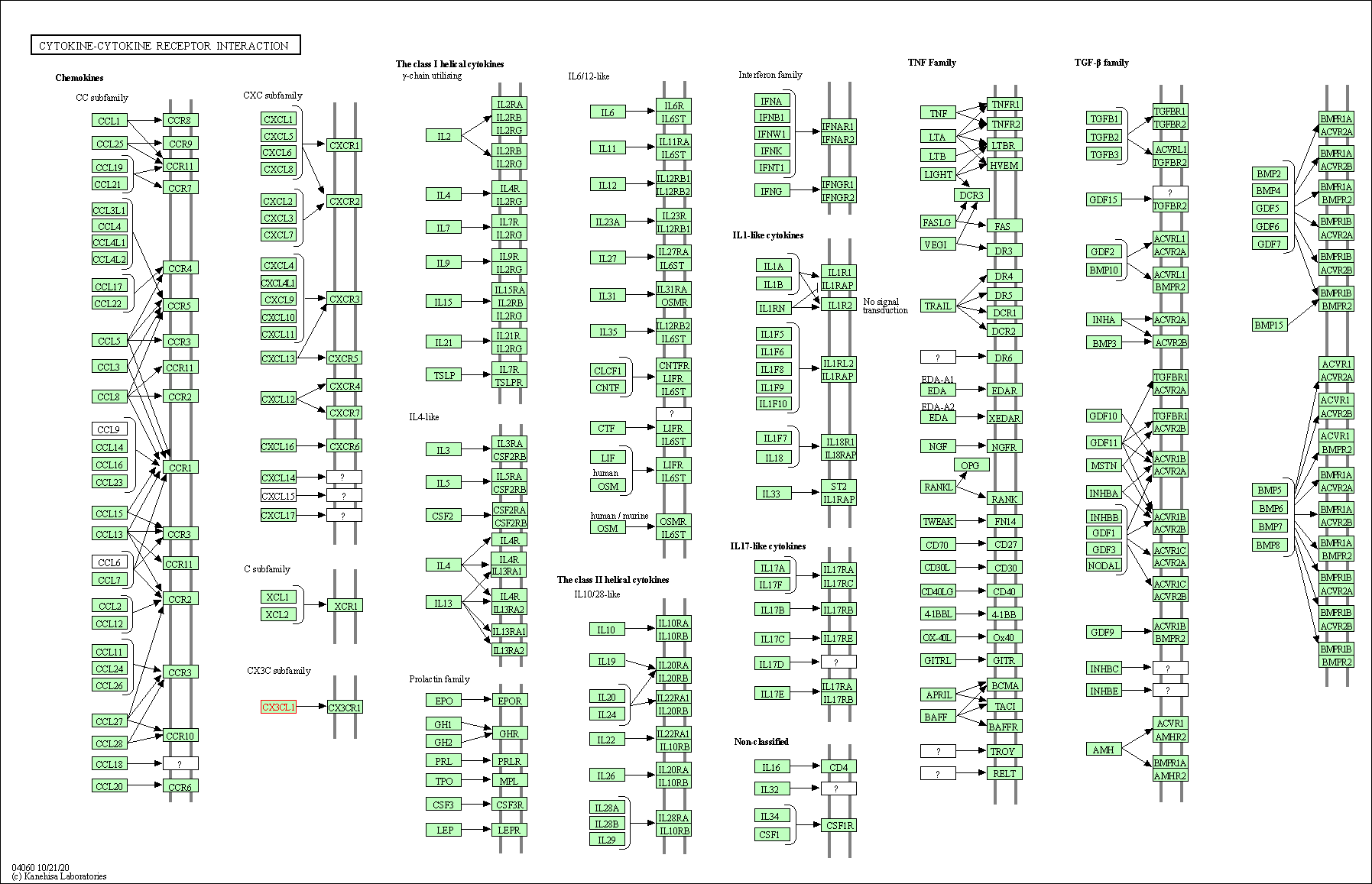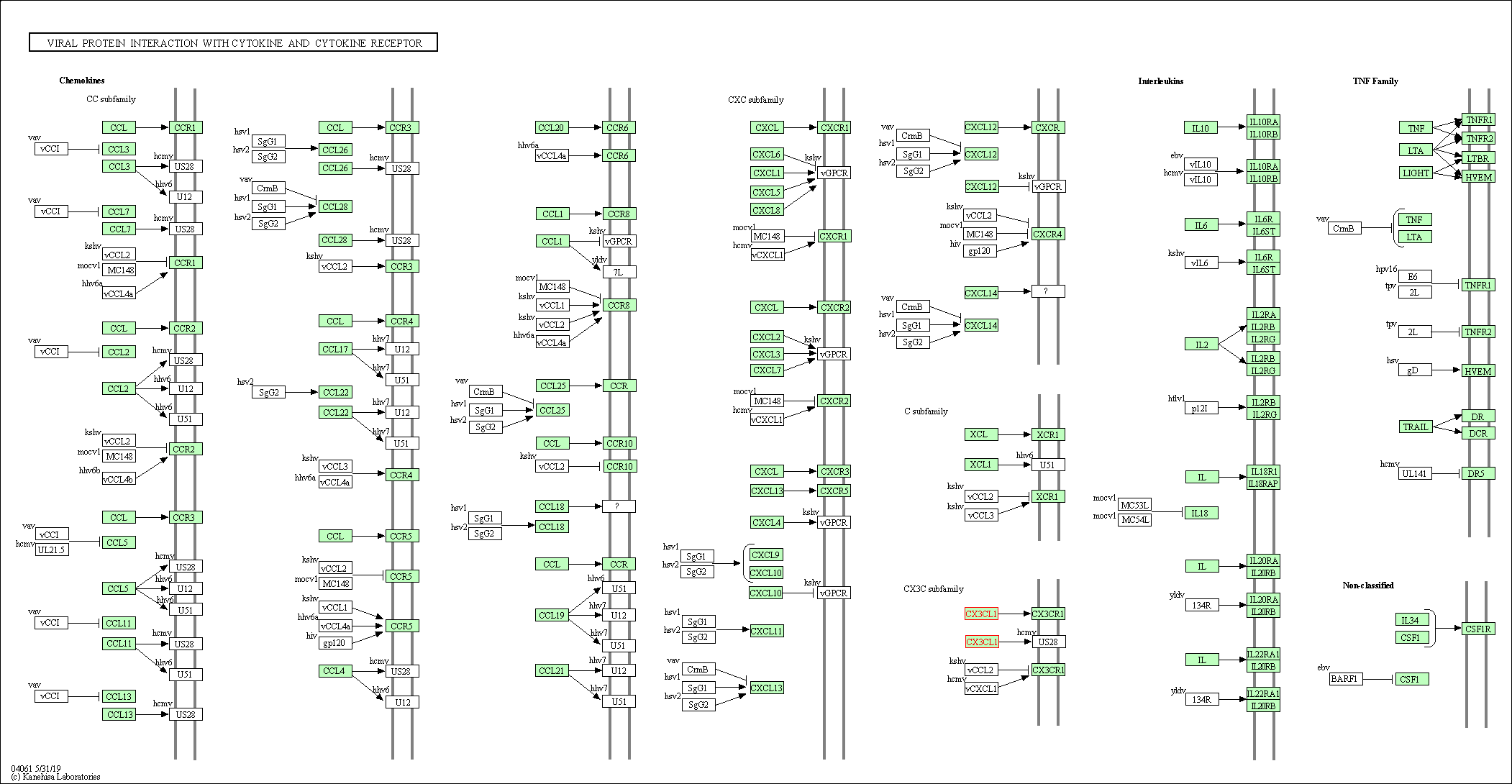Target Information
| Target General Information | Top | |||||
|---|---|---|---|---|---|---|
| Target ID |
T34405
(Former ID: TTDR00524)
|
|||||
| Target Name |
Fractalkine (CX3CL1)
|
|||||
| Synonyms |
Small-inducible cytokine D1; Small inducible cytokine D1; SCYD1; Neurotactin; NTT; FKN; CX3C membrane-anchored chemokine; C-X3-C motif chemokine 1; A-152E5.2
Click to Show/Hide
|
|||||
| Gene Name |
CX3CL1
|
|||||
| Target Type |
Literature-reported target
|
[1] | ||||
| Function |
Binds to CX3CR1. Binds to integrins ITGAV:ITGB3 and ITGA4:ITGB1. Can activate integrins in both a CX3CR1-dependent and CX3CR1-independent manner. In the presence of CX3CR1, activates integrins by binding to the classical ligand-binding site (site 1) in integrins. In the absence of CX3CR1, binds to a second site (site 2) in integrins which is distinct from site 1 and enhances the binding of other integrin ligands to site 1. The soluble form is chemotactic for T-cells and monocytes and not for neutrophils. The membrane-bound form promotes adhesion of those leukocytes to endothelial cells. May play a role in regulating leukocyte adhesion and migration processes at the endothelium. Acts as a ligand for both CX3CR1 and integrins.
Click to Show/Hide
|
|||||
| UniProt ID | ||||||
| Sequence |
MAPISLSWLLRLATFCHLTVLLAGQHHGVTKCNITCSKMTSKIPVALLIHYQQNQASCGK
RAIILETRQHRLFCADPKEQWVKDAMQHLDRQAAALTRNGGTFEKQIGEVKPRTTPAAGG MDESVVLEPEATGESSSLEPTPSSQEAQRALGTSPELPTGVTGSSGTRLPPTPKAQDGGP VGTELFRVPPVSTAATWQSSAPHQPGPSLWAEAKTSEAPSTQDPSTQASTASSPAPEENA PSEGQRVWGQGQSPRPENSLEREEMGPVPAHTDAFQDWGPGSMAHVSVVPVSSEGTPSRE PVASGSWTPKAEEPIHATMDPQRLGVLITPVPDAQAATRRQAVGLLAFLGLLFCLGVAMF TYQSLQGCPRKMAGEMAEGLRYIPRSCGSNSYVLVPV Click to Show/Hide
|
|||||
| 3D Structure | Click to Show 3D Structure of This Target | AlphaFold | ||||
| HIT2.0 ID | T06QUL | |||||
| Cell-based Target Expression Variations | Top | |||||
|---|---|---|---|---|---|---|
| Cell-based Target Expression Variations | ||||||
| Drug Binding Sites of Target | Top | |||||
|---|---|---|---|---|---|---|
| Ligand Name: Cholesterol | Ligand Info | |||||
| Structure Description | Cryo-EM structure of the human chemokine receptor CX3CR1 in complex with CX3CL1 and Gi1 | PDB:7XBX | ||||
| Method | Electron microscopy | Resolution | 3.40 Å | Mutation | Yes | [2] |
| PDB Sequence |
HHGVTKCNIT
11 CSKMTSKIPV21 ALLIHYQQNQ31 ASCCKRAIIL41 ETRQHRLFCE55 QWVKDAMQHL 65 DYIGDIVVFG132 TVFLSIFYSV142 IFAIGLVGNL152 LVVFALTNSK162 KPKSVTDIYL 172 LNLALSDLLF182 VATLPFWTHY192 LINEKGLHNA202 MCKFTTAFFF212 IGFFGSIFFL 222 TVISIDRYLA232 IVLAANSMNN242 RTVQHGVTIS252 LGVWAAAILV262 AAPQFMFTKQ 272 KENECCGDYP282 EVLQEIWPVL292 RNVETNFLGF302 LLPLLIMSYC312 YFRIIQTLFS 322 SKNHKKAKAI332 KLILLVVIVF342 FLFWTPYNVV352 IFLETLKLYD362 FFPSCDMRKD 372 LRLALSVTET382 VAFSHCCLNP392 LIYAFAGEKF402 RRYLYHLY
|
|||||
|
|
ILE219
4.835
PHE220
2.632
THR223
2.689
VAL224
3.553
ILE227
4.019
HIS247
3.614
THR250
2.542
ILE251
2.623
GLY254
3.397
VAL255
3.623
ALA258
4.046
LEU300
3.502
|
|||||
| Ligand Name: Pyroglutamic Acid | Ligand Info | |||||
| Structure Description | Structure of a nanobody-bound viral GPCR bound to human chemokine CX3CL1 | PDB:4XT1 | ||||
| Method | X-ray diffraction | Resolution | 2.89 Å | Mutation | Yes | [3] |
| PDB Sequence |
HHGVTKCAIT
11 CSKMTSKIPV21 ALLIHYQQNQ31 ASCGKRAIIL41 ETRQHRLFCA51 DPKEQWVKDA 61 MQHLDRQ
|
|||||
|
|
||||||
| Click to View More Binding Site Information of This Target and Ligand Pair | ||||||
| Click to View More Binding Site Information of This Target with Different Ligands | ||||||
| Different Human System Profiles of Target | Top |
|---|---|
|
Human Similarity Proteins
of target is determined by comparing the sequence similarity of all human proteins with the target based on BLAST. The similarity proteins for a target are defined as the proteins with E-value < 0.005 and outside the protein families of the target.
A target that has fewer human similarity proteins outside its family is commonly regarded to possess a greater capacity to avoid undesired interactions and thus increase the possibility of finding successful drugs
(Brief Bioinform, 21: 649-662, 2020).
Human Pathway Affiliation
of target is determined by the life-essential pathways provided on KEGG database. The target-affiliated pathways were defined based on the following two criteria (a) the pathways of the studied target should be life-essential for both healthy individuals and patients, and (b) the studied target should occupy an upstream position in the pathways and therefore had the ability to regulate biological function.
Targets involved in a fewer pathways have greater likelihood to be successfully developed, while those associated with more human pathways increase the chance of undesirable interferences with other human processes
(Pharmacol Rev, 58: 259-279, 2006).
Biological Network Descriptors
of target is determined based on a human protein-protein interactions (PPI) network consisting of 9,309 proteins and 52,713 PPIs, which were with a high confidence score of ≥ 0.95 collected from STRING database.
The network properties of targets based on protein-protein interactions (PPIs) have been widely adopted for the assessment of target’s druggability. Proteins with high node degree tend to have a high impact on network function through multiple interactions, while proteins with high betweenness centrality are regarded to be central for communication in interaction networks and regulate the flow of signaling information
(Front Pharmacol, 9, 1245, 2018;
Curr Opin Struct Biol. 44:134-142, 2017).
Human Similarity Proteins
Human Pathway Affiliation
Biological Network Descriptors
|
|
|
There is no similarity protein (E value < 0.005) for this target
|
| KEGG Pathway | Pathway ID | Affiliated Target | Pathway Map |
|---|---|---|---|
| Cytokine-cytokine receptor interaction | hsa04060 | Affiliated Target |

|
| Class: Environmental Information Processing => Signaling molecules and interaction | Pathway Hierarchy | ||
| Viral protein interaction with cytokine and cytokine receptor | hsa04061 | Affiliated Target |

|
| Class: Environmental Information Processing => Signaling molecules and interaction | Pathway Hierarchy | ||
| Chemokine signaling pathway | hsa04062 | Affiliated Target |

|
| Class: Organismal Systems => Immune system | Pathway Hierarchy | ||
| TNF signaling pathway | hsa04668 | Affiliated Target |

|
| Class: Environmental Information Processing => Signal transduction | Pathway Hierarchy | ||
| Degree | 1 | Degree centrality | 1.07E-04 | Betweenness centrality | 0.00E+00 |
|---|---|---|---|---|---|
| Closeness centrality | 1.07E-04 | Radiality | 3.98E-03 | Clustering coefficient | 0.00E+00 |
| Neighborhood connectivity | 1.00E+00 | Topological coefficient | . | Eccentricity | 1 |
| Download | Click to Download the Full PPI Network of This Target | ||||
| Target Regulators | Top | |||||
|---|---|---|---|---|---|---|
| Target-regulating microRNAs | ||||||
| References | Top | |||||
|---|---|---|---|---|---|---|
| REF 1 | Analysis of fractalkine receptor CX(3)CR1 function by targeted deletion and green fluorescent protein reporter gene insertion. Mol Cell Biol. 2000 Jun;20(11):4106-14. | |||||
| REF 2 | Activation of the human chemokine receptor CX3CR1 regulated by cholesterol. Sci Adv. 2022 Jul;8(26):eabn8048. | |||||
| REF 3 | Structural biology. Structural basis for chemokine recognition and activation of a viral G protein-coupled receptor. Science. 2015 Mar 6;347(6226):1113-7. | |||||
If You Find Any Error in Data or Bug in Web Service, Please Kindly Report It to Dr. Zhou and Dr. Zhang.

